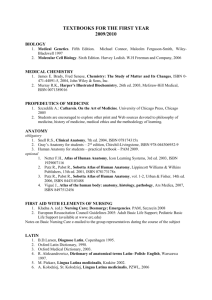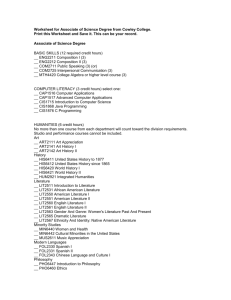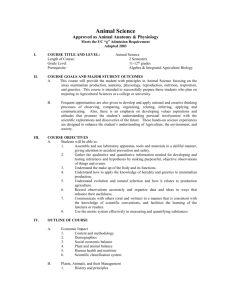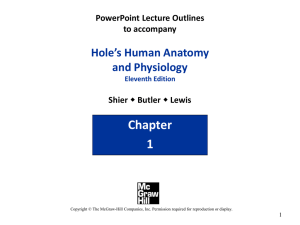Anatomy and Physiology
advertisement
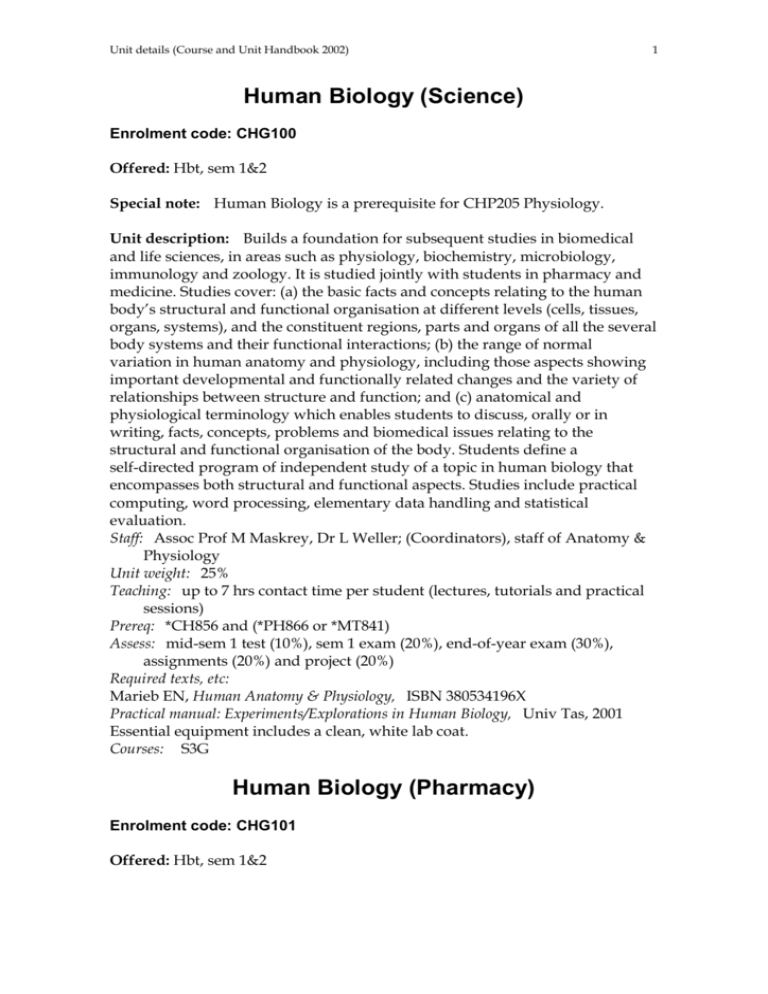
Unit details (Course and Unit Handbook 2002) 1 Human Biology (Science) Enrolment code: CHG100 Offered: Hbt, sem 1&2 Special note: Human Biology is a prerequisite for CHP205 Physiology. Unit description: Builds a foundation for subsequent studies in biomedical and life sciences, in areas such as physiology, biochemistry, microbiology, immunology and zoology. It is studied jointly with students in pharmacy and medicine. Studies cover: (a) the basic facts and concepts relating to the human body’s structural and functional organisation at different levels (cells, tissues, organs, systems), and the constituent regions, parts and organs of all the several body systems and their functional interactions; (b) the range of normal variation in human anatomy and physiology, including those aspects showing important developmental and functionally related changes and the variety of relationships between structure and function; and (c) anatomical and physiological terminology which enables students to discuss, orally or in writing, facts, concepts, problems and biomedical issues relating to the structural and functional organisation of the body. Students define a self-directed program of independent study of a topic in human biology that encompasses both structural and functional aspects. Studies include practical computing, word processing, elementary data handling and statistical evaluation. Staff: Assoc Prof M Maskrey, Dr L Weller; (Coordinators), staff of Anatomy & Physiology Unit weight: 25% Teaching: up to 7 hrs contact time per student (lectures, tutorials and practical sessions) Prereq: *CH856 and (*PH866 or *MT841) Assess: mid-sem 1 test (10%), sem 1 exam (20%), end-of-year exam (30%), assignments (20%) and project (20%) Required texts, etc: Marieb EN, Human Anatomy & Physiology, ISBN 380534196X Practical manual: Experiments/Explorations in Human Biology, Univ Tas, 2001 Essential equipment includes a clean, white lab coat. Courses: S3G Human Biology (Pharmacy) Enrolment code: CHG101 Offered: Hbt, sem 1&2 Unit details (Course and Unit Handbook 2002) 2 Unit description: Builds a foundation for subsequent studies in pharmacy. It is studied jointly with students in science and medicine. Studies cover: (a) the basic facts and concepts relating to the human body’s structural and functional organisation at different levels (cells, tissues, organs, systems), and the constituent regions, parts and organs of all the several body systems and their functional interactions; (b) the range of normal variation in human anatomy and physiology, including those aspects showing important developmental and functionally related changes and the variety of relationships between structure and function; and (c) anatomical and physiological terminology which enables students to discuss, orally or in writing, facts, concepts, problems and biomedical issues relating to the structural and functional organisation of the body. Students define a self-directed program of independent study of a topic in human biology that encompasses both structural and functional aspects. Studies include practical computing, word processing, elementary data handling and statistical evaluation. Staff: Assoc Prof M Maskrey, Dr L Weller (Coordinators), staff of Anatomy & Physiology Unit weight: 25% Teaching: up to 7 hrs contact time per student (lectures, tutorials and practical sessions) Prereq: *CH856 and (*PH866 or *MT841) Assess: mid-sem 1 test (10%), sem 1 exam (20%), end-of-year exam (30%), assignments (20%) and project (20%) Required texts, etc: Marieb EN, Human Anatomy & Physiology, ISBN 380534196X Practical manual: Experiments/Explorations in Human Biology, Univ Tas, 2001 Essential equipment includes a clean, white coat. Courses: M3F Integrated Structure and Function Enrolment code: CHG110 Offered: Hbt, sem 1&2 Special note: restricted to students enrolled in medicine Unit description: This unit provides an integrated study of the structure and function of the human body, with an emphasis on medical relevance. It establishes the background for Structure and Function ñ Clinical Correlations (2nd Year), which involves a more detailed study of structure and function with a greater clinical emphasis. A component of this unit (human biology) is studied jointly with science and pharmacy students. Learning opportunities comprise a lecture-based framework supplemented by practical work, small group workshops, tutorials and self-directed activities. The practical component Unit details (Course and Unit Handbook 2002) 3 comprises an introduction to surface anatomy and medical imaging, human dissection, observation and examination of tissue structure from sub-microscopic to macroscopic levels, and laboratory experiments designed for exploring general and fundamental principles of medical science and for introducing methods of collecting and analysing biomedical scientific data. The unit promotes an integrated understanding of structure and function at all levels (of cells, tissues, organs and systems) using a systemic approach complemented by regional study of the limbs. The unit also promotes the development of relevant observational, cognitive and communication skills. Students explore medically relevant aspects of all systems of the body (integumentary, skeletal, muscular, nervous, endocrine, cardiovascular, respiratory, immune, digestive, urinary and reproductive) along with their development, and consider some functions that range across several systems. Regional study of the body’s structure is continued in 2nd Year (thorax and abdomen) and completed in 3rd Year (head and neck), in association with neuroscience. Themes stressed in Integrated Structure and Function include (1) the interrelation of structure and function; (2) levels of organisation; (3) interactions of different systems; (4) normal ranges of variation; and (5) the structural and functional implications of injury and disease in humans. Staff: Dr WL Weller (Coordinator), staff of Anatomy & Physiology Unit weight: 50% Teaching: up to 14 hrs contact time weekly (lectures, tutorials, small group workshops, practical classes, project work) Prereq: admission to Medicine Assess: mid-sem 1 test (10%), sem 1 exams (25%), end-of-year exams (45%), project (10%), practical component (10%) Required texts, etc: an Atlas of Anatomy: either Anderson JE, Grant’s Atlas of Anatomy, ISBN 0683302647 or Gosling JA et al, Human Anatomy color atlas and text, ISBN 0723426570 an Atlas of Histology: or Netter FH, Atlas of Human Anatomy, 2nd edn, ISBN 0914168819 [p/b]; 0914168800 [h/b] either Kerr JB, Atlas of Functional Histology, ISBN 0723430721 or Young B and JW Heath, Wheater’s Functional Histology, ISBN 0443056188 a Medical Dictionary, and the following texts: either Hall-Craggs ECB, Anatomy as a Basis for Clinical Medicine, ISBN 0683096486 or Moore KL and AF Dalley, Clinically Oriented Anatomy, ISBN 0683061410 Lisowski FP, A Guide to Dissection of the Human Body, ISBN 9810235690 Marieb EN, Human Anatomy & Physiology, ISBN 380534196X Sadler TW, Langman’s Medical Embryology, ISBN 0683306502 Weir J and and PH Abrahams, Imaging Atlas of Human Anatomy, ISBN 0723422834 (plus CD-ROM v2.0 Win/Mac, ISBN 0723426317 Hinrichsen CFL and FP Lisowski, Anatomy Workbook, Univ Tas, 2001 Practical manual: Experiments/Explorations in Human Biology, Univ Tas, 2001 Unit details (Course and Unit Handbook 2002) 4 Essential Equipment includes: Two long white coats exclusively for use in the dissecting laboratory One pair of anti-splash safety goggles The following instruments: one pair of non-toothed dissecting forceps; one pair of fine, sharp-pointed forceps; one scalpel handle and blades; one pair of blunt-ended scissors; one pair of sharp-pointed scissors; probe or seeker. (Seek advice before obtaining these.) Courses: M3A M3B M4B Structure and Function – Clinical Correlations Enrolment code: CHG210 Offered: Hbt, sem 1&2 Unit description: Builds on the approach of CHG110 Integrated Structure and Function, in which students were introduced to microscopic anatomy, regional anatomy and the functional systems of the body. This is achieved by (a) reinforcing the knowledge and understanding of structure and function in a medical context that is imparted by the earlier unit; (b) extending the students’ knowledge and understanding of structure and function with a progressively more clinically orientated approach throughout the year. Structure and Function – Clinical Correlations is aimed at providing the detailed foundation required for clinical studies (medicine, surgery and pathology) as well as for neuroscience and pharmacology. The overall aim of Structure and Function – Clinical Correlations is to present an integrated unit on the structure and function of the major functional systems of the body, apart from the nervous system. The cardiovascular, respiratory, gastrointestinal and renal systems are covered extensively in terms of structure (clinical, dynamic, imaging and histological anatomy, and relevant developmental aspects) and function. Aspects of the reproductive, endocrine, musculoskeletal and host defence systems are covered in less detail. Material is presented in clinically relevant contexts, and features case presentations and hospital based projects. The unit is taught as a series of blocks (cardiovascular, respiratory, endocrine & reproductive, renal, gastrointestinal, and body defences) in which histological, anatomical and physiological aspects are taught and assessed in an integrated fashion. The major blocks start with an illustrative clinical problem that the students are expected to report on at the end of the block; in addition the main blocks conclude with a clinical synthesis or clinical case presentation. As a means of acquiring realistic clinically based practically orientated educational experience, students undertake a clinical project with a strong base in anatomical and physiological sciences eg cardiothoracic medicine/surgery, intensive care. Overall structural, functional and clinical integration is obtained Unit details (Course and Unit Handbook 2002) and assessed by the students having to prepare oral presentations on this project. Staff: Assoc Prof S Nicol, Dr J Walls (Coordinators), Assoc Prof M Maskrey, Dr I Chuah, Dr S Parkes, Clinical staff of RHH and other hospitals and other staff of Anatomy & Physiology. Unit weight: 37.5% Prereq: 1st-year Medicine Assess: in-course practical and project work (30%), 2 mid-year 2-hr written exams (essays, problem solving and multiple choice), 2x40-min practical exams (10%), 3 end-of-year written exams (essays, problem solving and multiple choice), 2x40-min practical exams, 15-min viva voce (60%) Required texts, etc: Ellis H, Clinical Anatomy, ISBN 0632024097 Interactive Lessons in Clinical Anatomy CD ROM, Standford Project Jacobsen Ed and Levine JS, Clinical Physiology for the Exam Taker, ISBN 0721637019 McMinns Interactive Clinical Anatomy CD ROM, Mosby Ross MH, Romrell LJ and Kaye GI, Histology: A Text and Atlas, ISBN 0683073699 Weir and Abrahams, Imaging Atlas of Anatomy, Wolfe, 1994 (plus CD ROM)~ either Est JB, Best & Taylor’s Physiological Basis of Medical Practice, ISBN 0683089471 or Berne RM and Levy MN, Physiology, ISBN0815109520 Reference text Young B, Heath JW (eds), Wheater’s Functional Histology. A Text and Colour Atlas, ISBN 0443056129 Courses: M3A M3B M4B 5


